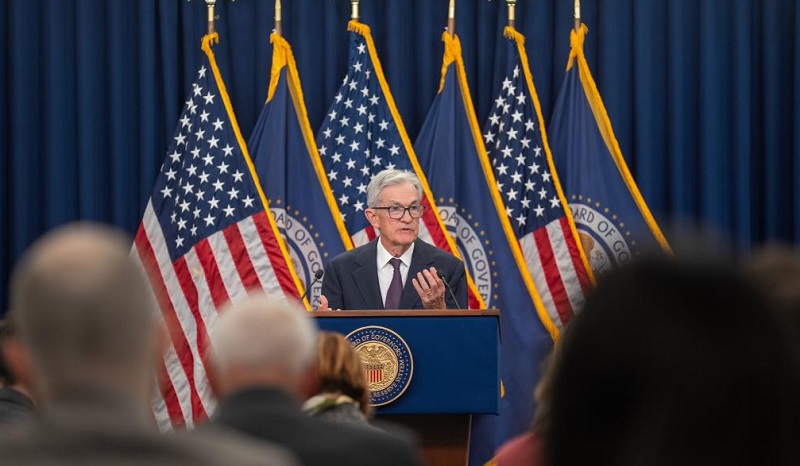On the 17th local time, the U.S. Federal Reserve concluded its two-day monetary policy meeting and announced a 25 basis point cut in the target range for the federal funds rate, bringing it to a range of 4.00% to 4.25%. This marked the Fed’s first rate cut in 2025 and followed three rate cuts in 2024. Investors began evaluating the Fed’s rate decision and forecasts, and U.S. stocks rallied. Meanwhile, concerns resurfaced about the Fed’s ability to maintain its independence.
Job growth slows, the balance of risks shifts, and the Fed cuts rates.
The Federal Open Market Committee, the Federal Reserve’s policymaking body, released a statement on the 17th, stating that U.S. economic activity slowed in the first half of the year, job growth slowed, the unemployment rate rose slightly, and inflation rose but remained somewhat elevated. The Committee seeks to achieve maximum employment and 2% inflation over the long term. However, uncertainty about the economic outlook remains high. The Committee noted the risks to its mandate and judged that downside risks to employment have increased. To support the achievement of the Committee’s goals and taking into account the shifting balance of risks, the Committee decided to lower the target range for the federal funds rate by 25 basis points to a range of 4.00% to 4.25%.
The Federal Reserve’s forecasts indicate another 50 basis point rate cut by the end of the year, with another 25 basis point cut each year for the next two years. Furthermore, the Fed released its latest outlook of economy on the 17th, with the “dot plot” showing that nine of the 19 Fed officials expect two more rate cuts this year, two expect one, and six believe there will be no further cuts.
Following the monetary policy meeting on the 17th, Federal Reserve Chairman Powell held a press conference at Fed headquarters. At the press conference, Powell stated: “In the short term, the risks to inflation are tilted to the upside, and the risks to employment are tilted to the downside—this is a tricky situation. When our goals conflict like this, our framework requires us to balance the two aspects of our dual mandate. As the downside risks to employment have increased, the balance of risks has shifted.”
US stocks closed mixed on the 17th.
US stocks closed mixed on the 17th after the Federal Reserve lowered its benchmark interest rate. The Dow Jones Industrial Average closed up 260.42 points, or 0.57%, after briefly turning negative. The S&P 500 fell 0.1%, and the Nasdaq Composite fell 0.33%.
Furthermore, the US dollar index briefly fell 0.4% after the Fed’s announcement, but erased those losses to rise 0.3% after Powell’s press conference. US Treasury yields initially fell before rising again before Powell emphasized inflation risks.
US media reported that while the stock market has rebounded in recent weeks on anticipation of a Fed rate cut, the outcome was not significant enough to trigger significant market volatility.
A strategist at JPMorgan Asset Management said the U.S. labor market is weakening, so the Fed believes a rate cut is appropriate, but they won’t do so quickly because of inflation concerns.
An economist at Oxford Economics said, “The accompanying ‘dot plot’ shows significant disagreement within the committee about whether further rate cuts are needed this year.”
With Trump’s chief economic advisor joining the fold, how can the Fed maintain its independence?
Since taking office in January, US President Trump has consistently pressured the Federal Reserve to cut interest rates, arguing that lower borrowing costs will boost economic growth. Trump has employed various tactics to exert pressure, including criticizing the Federal Open Market Committee and Powell and attempting to fire Powell, installing his chief economic advisor, Stephen Milan, on the committee (Milan retains his position in the Trump administration while serving on the Fed), and attempting to remove Fed Governor Lisa Cook. These actions have fueled concerns that the Fed will lose its independence under pressure.
According to a statement released by the Federal Open Market Committee on the 17th, the committee voted 11-1. Milan was the lone dissenting vote, favoring a 50 basis point rate cut. Furthermore, the “dot plot” shows that one official supports a significant rate cut in 2025. According to CNBC, this official, who may be Milan, believes a 125 basis point cut is needed this year.
At a press conference on the 17th, a reporter asked Powell how the Fed could maintain its perceived independence with Milan joining the committee. Powell gave a brief response, saying, “We are deeply committed to our independence, and beyond that, I don’t have anything to share.”












